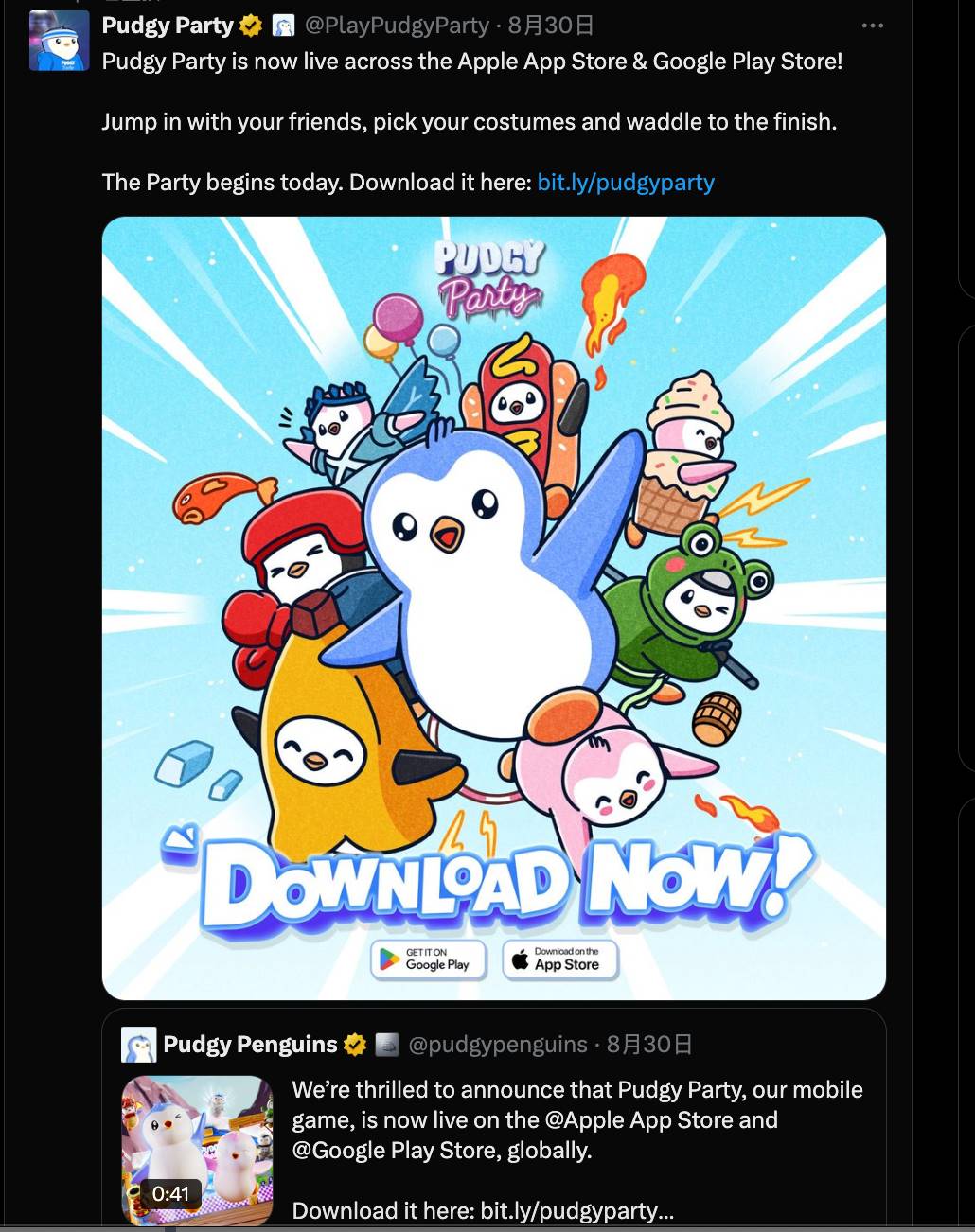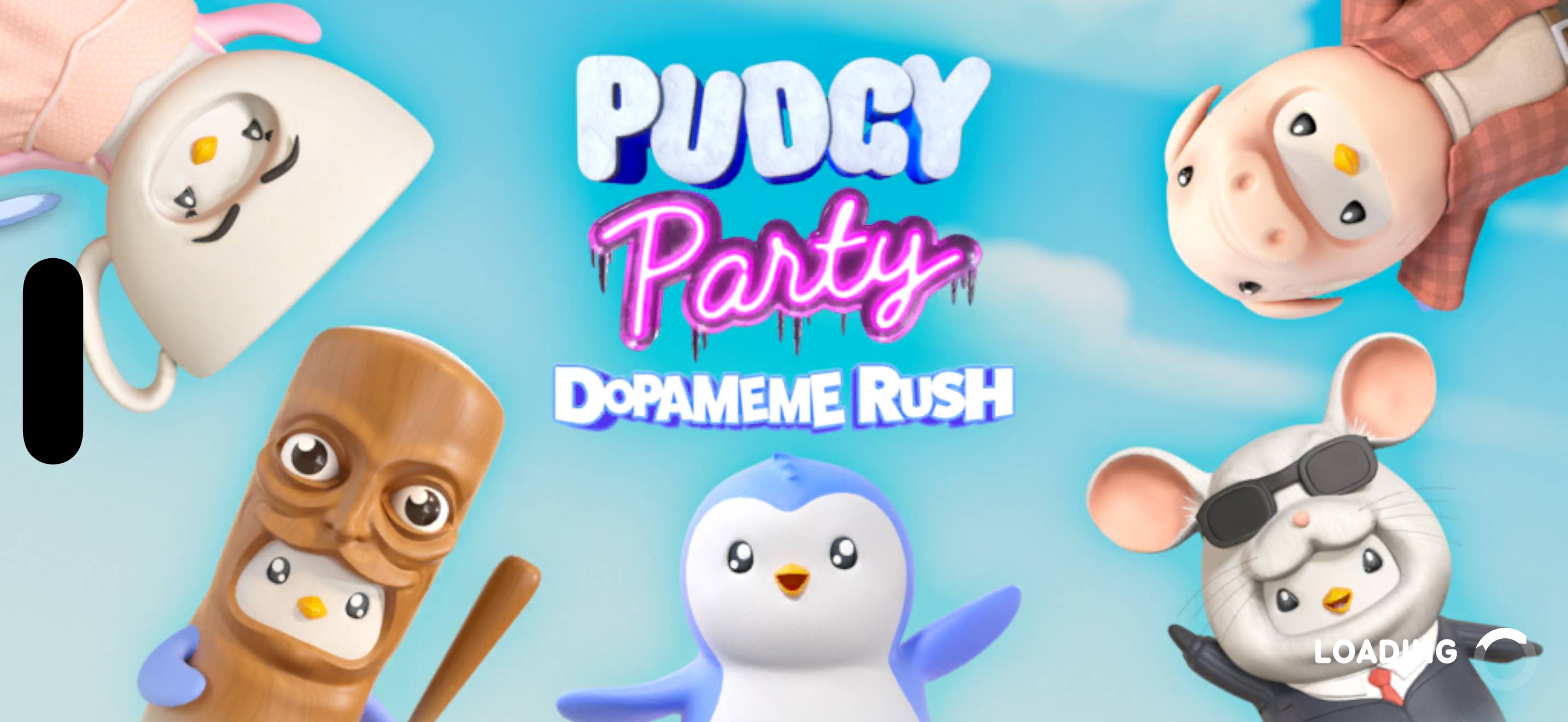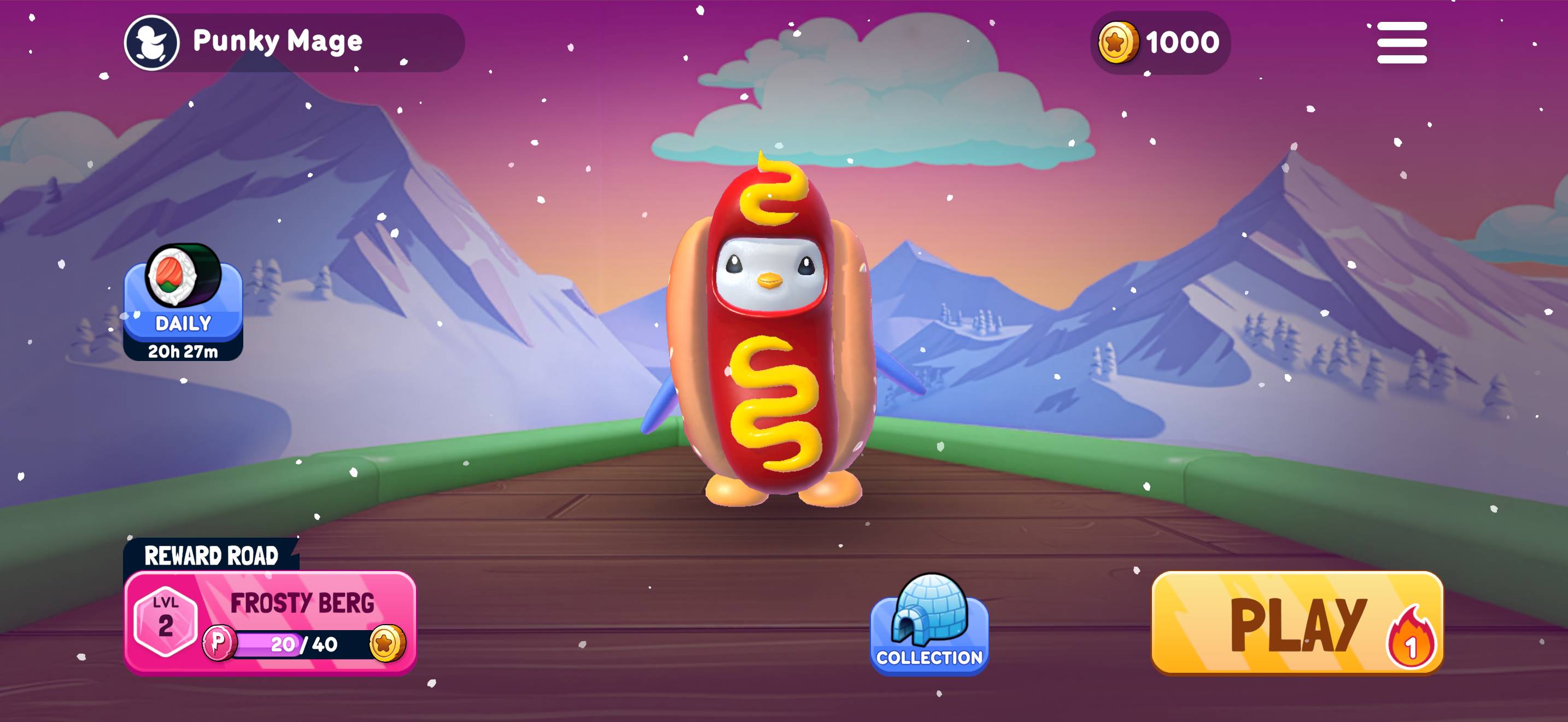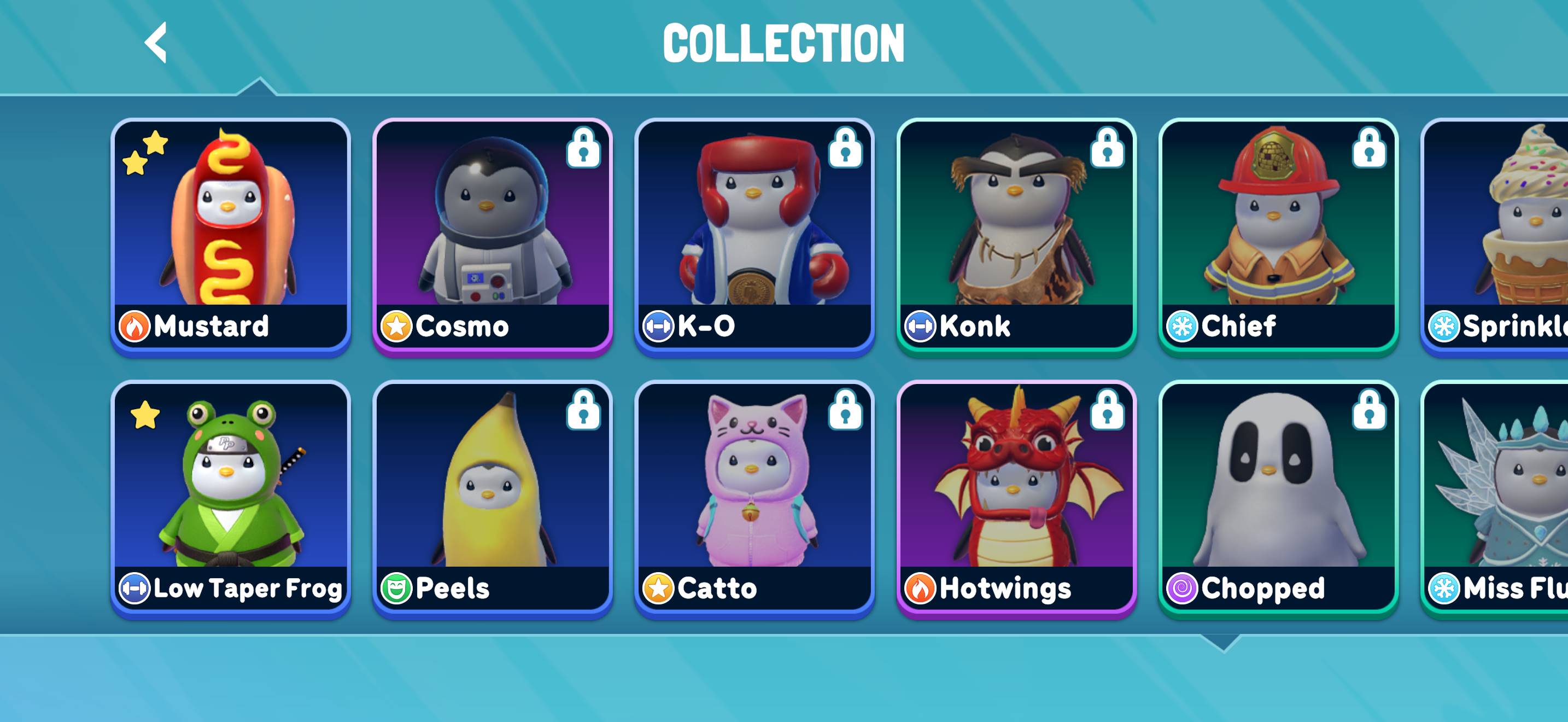Author: Deep Tide TechFlow
Two months ago, the little penguins of Pudgy Penguins just rang the bell on Nasdaq. Various institutions both inside and outside the industry, such as Coinbase and VanEck, even collectively changed their avatars for it.
It seems that for the little penguins, spreading their IP wider has become the main development line for one of the few surviving NFT projects in this space.
On August 30, Pudgy Penguins' new game Pudgy Party launched on major mobile game stores, further gamifying its IP. Meanwhile, according to some overseas KOL analyses, after the game was listed, it briefly reached the top 10 in the free games chart.

I recently downloaded the game to give it a try and found that it is very different from the blockchain games that deliberately emphasized the fusion of crypto and gaming in the previous cycle:
Pudgy Party has no wallet connection, no NFT marketplace, no on-chain token rewards… nothing at all. It is just an ordinary mobile party game, no different from the casual games you can download from the App Store.
Interestingly, the game is quite fun.
If you've played Fall Guys, you'll definitely chuckle when you enter the game interface; it's a mini-game where multiple players compete to be the last one standing, light-hearted and without any "gold farming" atmosphere, pure and even devoid of crypto flavor.
An NFT project has created a game that doesn't mention NFTs at all. After playing for a while, I also want to discuss this "not-so-Web3" Web3 game.

No Chain, Just Play
When you open Pudgy Party, your first reaction is: where's the wallet connection? There isn't one.
What about the NFT Marketplace? None. Token reward system? Still none.
In contrast, the benchmark blockchain game from the last cycle, Axie Infinity, requires you to buy three NFT pets to start playing. StepN requires you to buy NFT shoes. Even relatively "light" blockchain games usually have a prominent "Connect Wallet" button.
If it weren't for the iconic little penguin image from Pudgy Penguins appearing in the game, you might think this is just an ordinary party game.
Click "Play," and after a few seconds of matching, you'll enter the first round of the game with 19 other players. Each person controls a cute penguin, competing in various bizarre levels.

From the experience, this is a pure casual game + little penguin IP game.
For example, in a typical obstacle course level, 20 penguins mean 20 players racing on a track full of traps, with spinning hammers, moving platforms, and suddenly collapsing floors ahead. All you have to do is not fall off and reach the finish line.
But when 20 penguins crowd together, the scene becomes particularly chaotic and funny: some are knocked away by hammers, some are pushed off a narrow bridge, and others fall just before reaching the finish line.
It's that kind of lightness that has nothing to do with blockchain games.

First, there is no rank pressure. Although the game has a leveling system, it is purely to unlock new penguin skins and emotes, which does not affect matchmaking.
Second, there are rewards even if you lose. Even if you get eliminated in the first round, you can still earn experience points and some costume fragments. The system kindly displays "Better luck next time!" along with a comforting penguin expression.
Third, you can exit at any time. Exiting midway incurs no penalties, and there are no learning curves or resource investments for gold farming.
I specifically looked for any hidden crypto elements in the game, but the fact is, there are none, at least not at the beginning.
There are indeed two types of costumes in the game store, non-tradable and limited edition; theoretically, limited edition costumes could become NFTs. But the problem is, you can't find any entry point for minting or trading.
However, according to the developer Mythical Games, the game does have Web3 elements:
First, each player automatically creates a wallet based on Mythos Chain (Polkadot ecosystem). But this wallet is completely in the background; users cannot see the address, private key, or mnemonic phrase—nothing at all. You don't even know if this wallet really exists.
Finally, there is the PENGU token. The official statement says they are "exploring integration solutions," but there is no sign of the token in the game. No staking, no rewards, no consumption scenarios.

In other words, all Web3 features are in a state of "wishful thinking" and extremely restrained design; this de-Web3 approach is likely intentional.
Sir, Times Have Changed
From a timing perspective, the launch of Pudgy Party coincides with a narrative reconstruction period in the crypto market.
The GameFi narrative has cooled, the Play to Earn model has proven unsustainable, and people have demystified blockchain games and NFTs, with a sense of "even dogs don't play them" humor.
More importantly, Apple and Google still have many restrictions on applications with NFT trading features. Previous news has shown that major app stores require a 30% commission on all NFT transactions, which is almost fatal for Web3 games.
From the audience perspective, Pudgy Penguins clearly aims to reach a broader user base. There are over 3 billion mobile game players worldwide, while active on-chain users may be less than 100 million. If Web3 barriers are set from the start, it automatically excludes 99% of potential users.
From a product strategy perspective, this resembles a "Trojan horse" strategy.
First, attract users with a fun free game, establish a user base and gaming habits, and then gradually introduce Web3 elements. Once users have already fallen in love with the game and the IP, the resistance to accepting wallets and NFTs will be much lower.
In fact, many blockchain game projects in the last cycle also adopted this model in the later stages, but none sustained it for long. The key difference here may be that the little penguins have a stronger IP appeal, making it easier to see results with this approach.

This brings an interesting paradox: the most successful product of a Web3 project may be the least Web3 product.
When Pudgy Penguins plush toys sell out at Walmart, buyers actually don't need to know what an NFT is; when penguin emojis go viral on social media, users don't even need to connect a wallet.
When Web3 No Longer Emphasizes Web3
The launch of Pudgy Party may mark a watershed moment in the development thinking of NFT projects.
In the past, the logic for NFT projects making games was: I have NFTs → holders need more rights → make a game for them to play → conveniently issue a token. This is a closed loop from the inside out, serving the existing thousands of holders.
Pudgy Penguins reversed this: make a fun game → attract millions of users → they might buy toys → a very small number might buy NFTs. This is a funnel from the outside in, targeting mobile game players outside the circle.
Relying solely on token incentives and speculative trading cannot be sustained; true value must return to product and user experience.
An even more interesting observation is that Pudgy Penguins seems to have turned Web3 elements into a "premium option":
- Ordinary users: play a free game, buy a $10 plush toy
- Advanced users: collect limited edition costumes, participate in community events
- Core users: purchase NFTs, hold PENGU tokens
This is somewhat like the "freemium" model of internet products, first attracting a massive user base with free products, then converting some into paying users.
Only here, "paying" has become "going on-chain."
If this model succeeds, it means that some Web3 projects have found a sustainable business path, one that does not rely on bull markets or new investors, but instead earns money like normal companies through products and IP.
But what about the tokens?
This is the biggest controversy of the Pudgy model: if success can be achieved without tokens, then where is the value support for the tokens?
Currently, PENGU seems more like a stock in the Pudgy ecosystem; buying it is betting that this IP will grow larger, rather than because it has any actual utility.
But from another perspective, Disney's stock also doesn't allow you free entry into Disneyland, yet that doesn't prevent it from being a quality asset. The key is whether the company can continue to create value, not what "empowerment" the stock itself has.
Of course, this analogy is not entirely accurate.
Stocks have dividends and voting rights, while PENGU currently has nothing. This is also a problem the team needs to solve: how to provide tangible benefits to token holders without compromising the product experience.
If the narrative of the last cycle was "Everything on chain," then this cycle may be "Chain as backend": the blockchain retreats to the background, becoming a technological infrastructure rather than a product selling point.
Pudgy Penguins may inadvertently provide a grounded example, not making everyone crypto native, but making crypto invisible to ordinary people.
As for whether this model can succeed and be replicated by other projects, it is still too early to draw conclusions.
But at least, Pudgy Penguins offers a different possibility:
In an era where everyone is shouting "Web3," the most successful may be the one that doesn't mention "Web3."
免责声明:本文章仅代表作者个人观点,不代表本平台的立场和观点。本文章仅供信息分享,不构成对任何人的任何投资建议。用户与作者之间的任何争议,与本平台无关。如网页中刊载的文章或图片涉及侵权,请提供相关的权利证明和身份证明发送邮件到support@aicoin.com,本平台相关工作人员将会进行核查。




